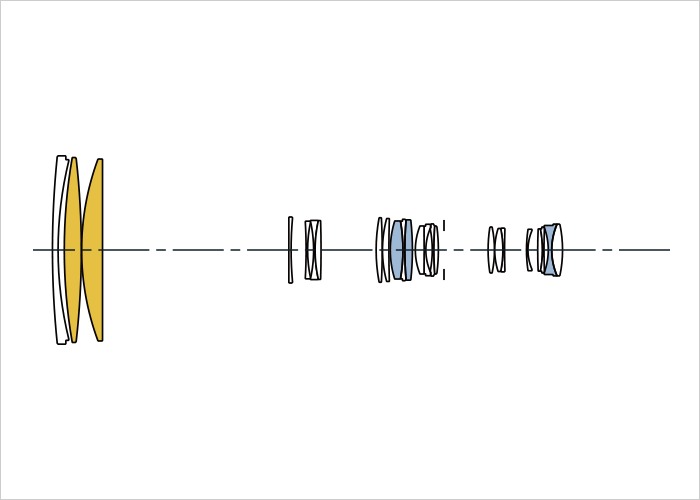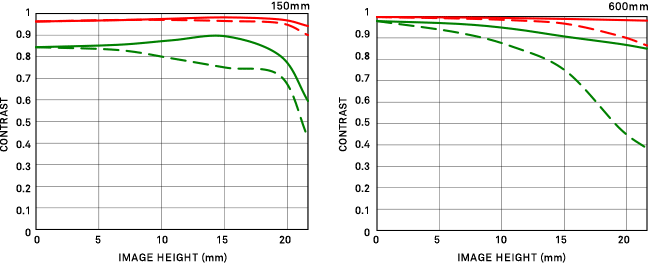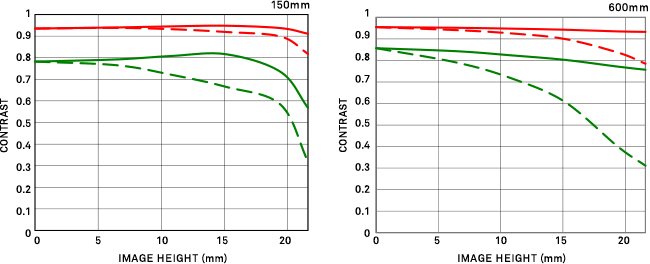150-600mm F5-6.3 DG OS HSM | S

• High action-capture performance
• Dust and splash-proof construction
• Water & oil repellent coating on the front and rear glass elements
• Customization and flexible adjustment with Sigma USB Dock
• Soft cap, Lens hood LH1164-01, case included
| Product Lines | Sports | |
|---|---|---|
| Youtube Videos | ||
| Instagram Widget | ||
| Construction | 24 Elements in 16 Groups | |
| Lens Type | Telephoto | |
| Sensor Size | Full Frame | |
| Angle of view | 16.4º - 4.1º | |
| Number of diaphragm blades | 9 (Rounded Diaphragm) | |
| Minimum aperture | F22 | |
| Minimum focusing distance | 260 cm / 102.4 in | |
| Maximum magnification ratio | 1:5 | |
| Dimensions (diameter x length) | ||
| --- | 2860 g / 100.9 oz | |
| Filter diameter | 105mm | |
| Edition number | S014 | |
| Accessories | Lens hood (LH1164-01) supplied. | |
| EAN | Canon EF |
|
Lens Construction


Geometrical MTF Chart


Diffraction MTF Chart


Dust and Splash Resistant Structure
This lens features a highly effective dust and splash resistant structure with special sealing at the mount connection, manual focus ring, zoom ring, and cover connection.
Note: Although this construction allows the lens to be used in light rain, it is not the same as being waterproof, so please prevent large amounts of water from splashing on the lens. It is often impractical to repair the internal mechanism, lens elements and electric components if they are damaged by water.
High-precision, rugged brass bayonet mount
The brass mount combines high precision with rugged construction. Its treated surfaces and enhanced strength contribute to the exceptional durability of the lens.
Water and oil repellent coating
Incorporates a water and oil-repellent coating that allows water to be wiped away easily and prevents oil and fat from sticking to the surface, even in challenging shooting conditions. At the same time, the maintenance of the lens surface becomes easier.
Zoom lock switch (Can be set at any indexed focal length)
This zoom lock switch enables the zoom ring to be locked at any indexed focal length. It can be fixed at the photographer's desired focal length, which allows stable shooting even when the lens is positioned upward or downward. This feature is also useful during long-exposure photography.
Dual Action Zoom
"Dual action zoom" supports both straight zoom and ring zoom.
HSM (Hyper Sonic Motor)
The Hyper Sonic Motor (HSM) is an original Sigma development that uses ultrasonic waves to drive the autofocus mechanism. Its extremely quiet operation helps avoid disturbing photographic subjects. High torque and speed assure rapid autofocus response. Sigma uses two types of HSM: ring HSM and micro HSM. The Ring HSM configuration permits manual fine tuning of focus (manual override) by turning the focusing ring after autofocus is complete.
Rounded diaphragm
The polygonal shape of a conventional iris dia phragm causes out-of-focus light points to appear polygonal. A rounded diaphragm is designed to pro duce rounded out-of-focus light points when opened to near maximum aperture. This creates attractive bokeh effects in many situations, such as when pho tographing a subject against an out-of-focus surface of water from which light is being reflected.
Intelligent OS
Intelligent OS is an algorithm specially designed for panning shots. It enables effective image stabilization even when the camera is moved vertically or diagonally, regardless of the horizontal and vertical orientation. This feature is available on all of Sigma's telephoto lenses that have OS switches 1 and 2, with the exception of the Sigma 120-300mm F2.8 DG OS HSM | Sports.
Exclusive low-dispersion glass
The degree to which light is refracted by glass depends on the light's wavelength. This fact causes different colors of light to focus at slightly different points. The result is chromatic aberration, the color fringing that is particularly noticeable in telephoto lenses. Most chromatic aberration can be removed by combining a high-refractivity convex lens element with a low-refractivity concave element. Yet residual chromatic aberration known as "secondary spectrum" may still remain. To minimize this secondary spectrum, which can be a serious issue with conventional lenses, Sigma lenses feature up to three types of exclusive low-dispersion glass offering superior performance: ELD (Extraordinary Low Dispersion), SLD (Special Low Dispersion) and FLD ("F" Low Dispersion). In particular, FLD glass offers ultra-low dispersion in combination with high transmittance and the anomalous dispersion characteristics of fluorite. Meticulous deployment of these types of exclusive low-dispersion glass and optimization of power distribution gives Sigma lenses superlative image rendition undiminished by residual chromatic aberration.
